Of course, at my comic-buying peak (1971 to 1980 or so), I bought everything that came out from the Big Two (which were, for all practical purposes, the only two most of the time). Well, maybe not everything: I got all the superheroes (solos, groups, and team-ups); all the war books (the great DC ones and the crappy Marvel ones); all the westerns (even the reprint titles), and all the one-offs like Kirby's In the Days of the Mob. I didn't buy Archies or funny animals or romance, and stayed away from the more expensive stuff, like the Warren magazines that were starting to come out, but I would walk to the Bay Ridge Stationery every Tuesday and come home with ten or more funnybooks. At the same time, I was backfilling some series, and getting close to having complete runs of titles such as JLA and Daredevil. I was sketching as many (or more) shots of Spider-man in my school notebooks as I was the Atom.
But in sensibility, I was always a DC man. A lot of my friends talked about how Marvel was "more realistic" or "more mature" or "more sophisticated" or more-something-or-other; I guess I never saw it, at least enough to let it make a difference to me.
That's all a prelude to the next item in The Shortbox, a two-issue story that is technically a Marvel adventure, but which is DC in more ways than one.
The Avengers 85 & 86, 1970-71
Roy Thomas, Writer
John Buscema & Sal Buscema, Artists (respectively)
John Buscema & Sal Buscema, Artists (respectively)
Before we even get inside the books, look at those covers -- plastered with word balloons and/or blurbs, portraying (or approximating) a scene from the story, showing characters who are describing the action that is taking place to no one in particular -- and tell me how they are more anything than any standard Silver Age cover. Looking at issue 86, I can squint and turn the ghostly heroes into Batman, Wonder Woman, and the Flash without half-trying, and it looks fine.
The blurb on that issue is the key to the significance of this story, although technically it is not the Squadron Sinister that returns, but the Squadron Supreme that debuts. But that distinction hardly matters, since the Squadron is the Justice League anyway.
See, about a year or so earlier, Roy Thomas had written some JLA-analogues into an Avengers story as villains: The Squadron Sinister. It was apparently intended as a one-time homage.
These issues were both a reprise of that idea and the development of a mutual homage, since some Avengers-analogues appeared in JLA the same month as this story began. In-story, the new faux-JLAers in The Avengers were not the same folks as the earlier ones, were heroes (The Squadron Supreme) instead of villains, and included more members than the original four.
In fact, all three groups went on to have more-or-less extensive careers and the usual tangled continuities; you can read all about that elsewhere on the net, maybe starting here, and it's worth the time. I just thought it would be fun to take a look at an early, less complicated version.
First of all, this is the Avengers line-up were dealing with:
The Avengers line-up is like the cast of Saturday Night Live: there are good times and bad times. I think this bunch is pretty solid, although I am no Avengers historian. I remember liking this version of the Black Knight, thinking that Clint Barton was an even bigger jerk as Goliath than he was as Hawkeye, getting frequently bored with Wanda and Pietro, and, of course, loving the John Buscema art no matter what. (I also think that John drew some of the best Superman art going, and wish he had done more.)
These Avengers, a few seconds from a tussle in another dimension, are teleporting home, except that four of them (Vision, Scarlet Witch, Quicksilver, and Goliath) wind up on an Earth-One analogue. After some unexplained glimpse of a future global disaster, they run into the Squadron Supreme at their headquarters (unclear antecedent intentional) and, of course, fight them. Here's the roll call of the JLA, er, the SS:
Nighthawk is a pretty good Batman stand-in. He's not much like the hardcase, master strategist we know today, but more like the adventurous detective of the time.
Tom Thumb is not a whole lot like the Atom, except that he's little (I'd guess about two feet tall). He doesn't change size, but has lots of gadgets.
Lady Lark might be a little too close to that era's version of Black Canary, even for homage.
American Eagle is Hawkman, with a layer of Captain America on top and streusel swirl of stupidity. (Later versions changed the name and concept to be more like Hawkman, or at least less annoying; I believe the new character is revealed to be the Eagle's son.) Hawkeye (couldn't they think of a different archery-related name?) filled the Green Arrow slot. I have found that all archery-gimmick characters are about the same, and this Hawkeye is not distinctive (except for dropping some, but not all, of his aitches in what I think is an English accent.)
After clearing up the misunderstandings (well, with Nighthawk, anyway - they leave the others unconscious; I guess it just seemed easier), Nighthawk and the Avengers head off to Cosmopolis (how cool -- a mock-DCU place name!) to find the other SS members in order to stop them from launching a rocket that will (unbeknownst to them) trigger the end of the world. Of course, the Avengers have to fight them first.
Hyperion is the SS Superman, although he seems more just "the big muscle" rather than "the Big Red H," if you know what I mean.
Doctor Spectrum is the Green Lantern counterpart. He appears to be the leader and seems a lot smarter than Hal Jordan; maybe that's because he doesn't get hit in the head once in the entire story. Whizzer (another recycled name) is the Flash, with a pretty goofy costume, except for the goggles, which I always thought were a nice touch.
These three and Nighthawk form the "classic" Squadron Supreme (i.e., the same characters as the Squadron Sinister) and it is with these four that our four Avengers team up to face the villain of the piece (who was behind that deadly-rocket business), a ten-year old boy:
Just your standard-issue super-genius, social-misfit, tool-of-the-government, exposed-to-radiation-at-birth, prepubescent evil mastermind.
In a clear nod to typical JSA and JLA plot arcs (not to mention the original "crisis" crossovers), the heroes confront Brain-Child (yeah, that's his name) on his island fortress (to stop his back-up plan for destroying the Earth) by breaking up into four pairs (matching up heroes from each group) and advancing against separate threats. In one episode from this struggle, we get a veritable catalogue of Silver-Age goodness, as well as proof that DC heroes are better than the Marvel heroes, even when they are DC-like:
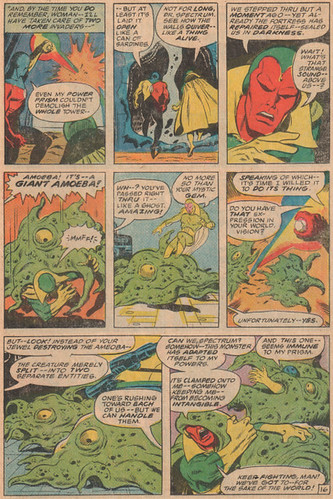
Ongoing exposition: Don't just show the action - explain it as well!
Green Lantern butt-shot: Well, it's actually Doc Spectrum's butt, and it's not very good shot, but I'm counting it.
A giant amoeba: How silver can you get?
Bonus giant amoeba goofiness: Doesn't the nucleus seem like an eye, watching the heroes at all times?
Poorly-used or self-conscious slang: Watch the Power Prism do its thing!
Irony: Don't blast an amoeba in two, you dopes! Especially super-adaptable ones.
Proof DC heroes (even Hal Jordan) are smarter than Marvel heroes: Look at that last panel. In the same circumstances, Green Lantern would have zapped J'onn J'onzz's amoeba into a big wastebasket or something, and J'onn would have blown GL's amoeba away with Martian breath, and they would have shared a homely moment about teamwork. These guys just stay smooshed for the rest of the fight.
So, the combined groups eventually reach victory only when a battered Goliath uses an unconscious Hyperion as an arrow in a makeshift giant bow to shoot Brain-Child's control pod. I'm kidding. No, I'm not kidding.
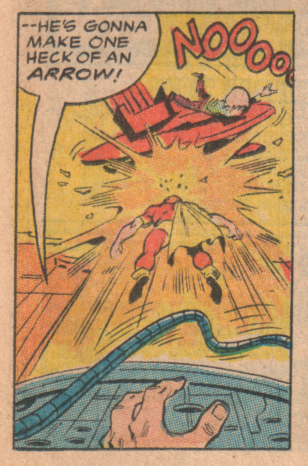
After de-geniusifying the kid, the Avengers are somehow dragged back home by a combination of Mjolnir's power and Stark technology. The story ends with the Vision wondering if they are back on their own Earth or perhaps on yet a third Earth. Shades of a Crisis that was still over two decades away! Or Sliders, even. (That musing must have been the more-sophisticated part.)
Looking back on the story now, I don't think it has aged particularly well. While the art is splendid and the action is fun, I have skimmed over much of Thomas's purple prose and heavy-handed literary allusions as well as several big plot holes with thin patches over them. But when this comic came out, the Superman/Spider-man crossover special was still about five years off; seeing a JLA/Avengers crossover, or any DC/Marvel crossover, even in a disguised form, was really quite a treat, especially for a sometime switch-hitter like myself.
Additional notes:
In 38 pages, this story has one splash page, 31 six- or nine-panel grids (or close), and six other page layouts.
Remember way back there at the beginning of this post, when I talked about backfilling my collection? That was when dinosaurs ruled the Earth and there weren't many comic shops. My buddies and I would take the bus from the Port Authority Terminal in Manhattan (I lived in Brooklyn) out to this store, whose ad was in these issues:

I got their catalog in the mail, a ditto-copy of a manually-typed list; the 'e' was blurry, so it always looked like Groon Lantorn. We'd bus out, pick up an armload of back issues, grab a grilled cheese at the Woolworth's, and read most of 'em on the bus and subway rides home.
Geez, I sound like Wilford Brimley.
Green Lantern butt-shot: Well, it's actually Doc Spectrum's butt, and it's not very good shot, but I'm counting it.
A giant amoeba: How silver can you get?
Bonus giant amoeba goofiness: Doesn't the nucleus seem like an eye, watching the heroes at all times?
Poorly-used or self-conscious slang: Watch the Power Prism do its thing!
Irony: Don't blast an amoeba in two, you dopes! Especially super-adaptable ones.
Proof DC heroes (even Hal Jordan) are smarter than Marvel heroes: Look at that last panel. In the same circumstances, Green Lantern would have zapped J'onn J'onzz's amoeba into a big wastebasket or something, and J'onn would have blown GL's amoeba away with Martian breath, and they would have shared a homely moment about teamwork. These guys just stay smooshed for the rest of the fight.
So, the combined groups eventually reach victory only when a battered Goliath uses an unconscious Hyperion as an arrow in a makeshift giant bow to shoot Brain-Child's control pod. I'm kidding. No, I'm not kidding.

After de-geniusifying the kid, the Avengers are somehow dragged back home by a combination of Mjolnir's power and Stark technology. The story ends with the Vision wondering if they are back on their own Earth or perhaps on yet a third Earth. Shades of a Crisis that was still over two decades away! Or Sliders, even. (That musing must have been the more-sophisticated part.)
Looking back on the story now, I don't think it has aged particularly well. While the art is splendid and the action is fun, I have skimmed over much of Thomas's purple prose and heavy-handed literary allusions as well as several big plot holes with thin patches over them. But when this comic came out, the Superman/Spider-man crossover special was still about five years off; seeing a JLA/Avengers crossover, or any DC/Marvel crossover, even in a disguised form, was really quite a treat, especially for a sometime switch-hitter like myself.
Additional notes:
In 38 pages, this story has one splash page, 31 six- or nine-panel grids (or close), and six other page layouts.
Remember way back there at the beginning of this post, when I talked about backfilling my collection? That was when dinosaurs ruled the Earth and there weren't many comic shops. My buddies and I would take the bus from the Port Authority Terminal in Manhattan (I lived in Brooklyn) out to this store, whose ad was in these issues:

I got their catalog in the mail, a ditto-copy of a manually-typed list; the 'e' was blurry, so it always looked like Groon Lantorn. We'd bus out, pick up an armload of back issues, grab a grilled cheese at the Woolworth's, and read most of 'em on the bus and subway rides home.
Geez, I sound like Wilford Brimley.
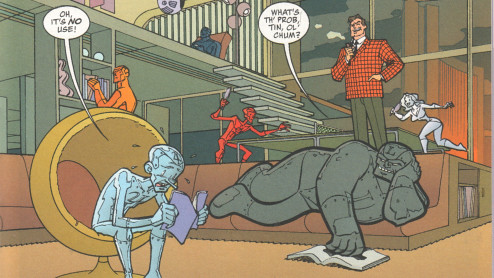
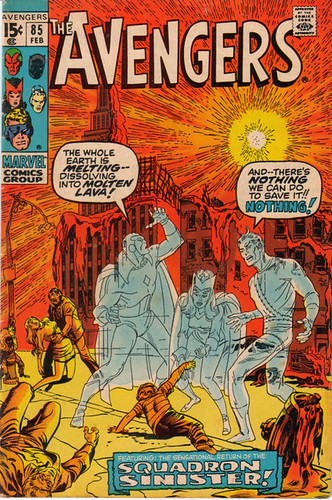
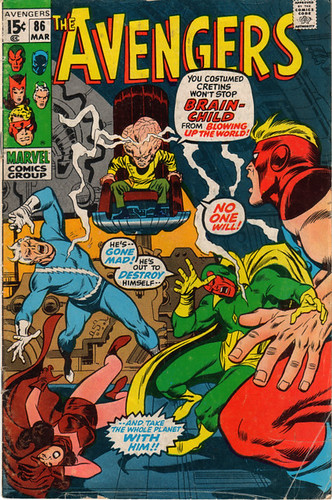
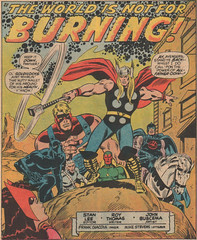
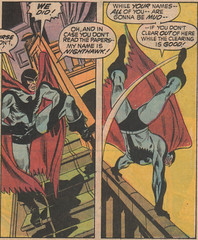
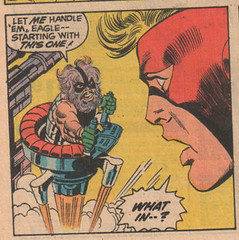

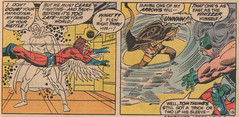
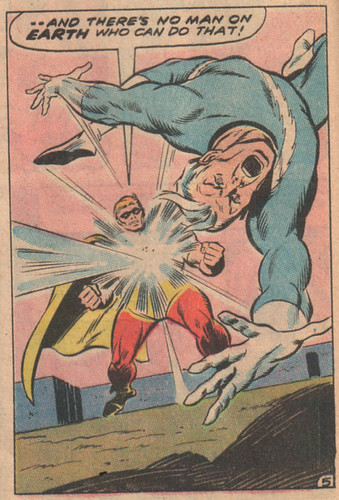
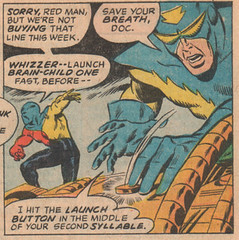
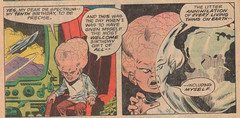


4 comments:
"In the same circumstances, Green Lantern would have zapped J'onn J'onzz's amoeba into a big wastebasket or something, and J'onn would have blown GL's amoeba away with Martian breath, and they would have shared a homely moment about teamwork."
So true, so true.
Roy Thomas = BrainChild, by the way. IN FACT, the JLU cartoon made the connection explicit in its JSA homage where they work with the "Justice Guild" versus a bigheaded mutant child who wants to keep the world exactly like a Golden Age comic book...
Clint Barton was an even bigger jerk as Goliath than he was as Hawkeye
I guess those amazing "Pym Particles" enlarged his jerkery to gigantic size as well.
Scipio: I saw that JLU! (I don't see much regular TV.) I never made the RT connection - but it's obvious, innit?
Cap: "Pym particles"? I guess I did miss something somewhere - I thought it was a serum.
Walaka,
Where can I and the boys find info on the various incarnations/memberships of the Justice League?
Post a Comment